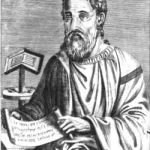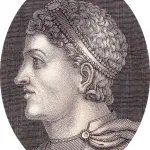Chapters
According to ancient sources, on the evening of October 27, 312 CE, just before the battle at the Milvian Bridge, Constantine the Great was to have a vision that led him to victory with the support of a Christian god. Historical sources, however, are not consistent and differ on certain issues as to the so-called “miracle of Constantine”.
The incredible event that was to take place before the battle is presented in two important accounts: Lactantius, who described the event at the earliest, and Eusebius of Caesarea, the bishop who stated that he was based on direct message he received from Constantine.
After the events described, Lactantius was the educator of the imperial firstborn son, Crispus. According to Lactantius, the night before the battle, Constantine was admonished during sleep to put a sign of God on the shields of his soldiers, which appeared in the sky. Lactanrtius’ message:
Constantine was directed in a dream to cause the heavenly sign to be delineated on the shields of his soldiers, and so to proceed to battle. He did as he had been commanded, and he marked on their shields the letter X, with a perpendicular line drawn through it and turned round thus at the top, being the cipher of CHRIST. Having this sign, his troops stood to arms.
– Lactantius, On the Death of the Persecutors, 44
The sign on the shields was a monogram of Christ: the letter X (in the Greek alphabet denoting Ch) was crossed by a bent letter I at the top, which was similar in shape to the letter P (in the Greek alphabet the letter R).
Another version was given to us by Eusebius of Caesarea. Eusebius of Caesarea knew nothing of any miraculous signs in the sky. According to Eusebius, Constantine I saw the sign during the evening prayer. This is how Bishop Eusebius describes this event:
But since the victorious emperor himself long afterwards declared it to the writer of this history, when he was honored with his acquaintance and society, and confirmed his statement by an oath, who could hesitate to believe it, especially since other testimonies have established its truth? He said that about noon, when the day was already beginning to decline, he saw with his own eyes the sign of a cross of light in the heavens, above the sun, and bearing the inscription, “By this symbol you will conquer.” He was struck with amazement by the sight, and his whole army witnessed the miracle.
– Eusebius, Life of Constantine, 1.28
The vision from ‘Living the Constantine’ displaced the earlier sleeping Constantine. The bishop also notes that the description he puts in his life comes from the emperor himself, who, many years after the event, described it to the author. This version is present in historians such as, for example, Socrates of Constantinople or Sozomen. Socrates relies directly on Eusebius, while Hermiah remains dependent on Socrates in his relationship. It is worth adding that for the bishop, the sign of God’s help for Constantine was the bridge breaking and the death of Maxentius, which the author compares to the destruction of Pharaoh’s army.
As you can see, the description of the miracle has evolved from a dream vision to a sign in the sky. The reality of the vision and its form give rise to numerous doubts and discussions by historians. The shape of the sign that Constantine saw was variously described (it could have been a chrism or a monogrammatic cross). Professor Adam Ziółkowski is looking for a consensus claiming that neither Constantine’s monogrammatic cross nor chrism appeared, but a simplified version of the standard. The sign was to be an outline of the later symbol of the Empire, which in this form was found on the shields only for technical reasons.
Nevertheless, the meaning of the vision was clear – the battle at the Milvian Bridge was the victory of the emperor, supported by Christ, over the pagan Maxentius. The victory was to be proof and the beginning of the reign of new faith and order.
Pagan version
Another concept of “Constantine’s vision” indicates that the event may have occurred earlier, and that it was actually a “pagan vision.” It is believed that the event of 312 CE was merely a reflection of the pagan vision that Constantine in Gaul was to experience in 310. Constantine, upon learning that the Germans are planning an invasion from behind the Rhine (after information about Maximian’s rebellion), went on to head the army north from Masalia. However, when it turned out that the threat was over, the future emperor was to go to the temple, probably above the upper Meuse, in today’s city of Grand.
There, according to panegyric, he was to experience revelation near the temple of Apollo and Victoria. According to the praise speech, the future emperor was to receive a laurel with three letters X inside, each of which symbolized 10 years of rule. As the vision took place near the temple of Apollo, where he was also worshiped, the event began to be combined with the popular cult of Sol Invictus, with which Constantine was strongly associated. According to N. Lensky, in 312 CE the emperor had just painted the sign XXX on the shields of soldiers. It may also be the letter T – the first letter of the Latin word ter (“three times”) inscribed in the number X, which would mean “three times ten”. It is worth mentioning that the reign of Constantine is a period of strong propaganda. It was believed that eventually there would be a golden age, the revelation of which will be the Sun of Justice and happiness in the sky. In particular, one can see a reference to the fourth eclair of Virgil’s. The event described in 310 CE was to be just that moment.
Proponents of “pagan theory” believe that the sign of the six-pointed star, that is, crossed with an X vertical line, is found in various countries and cultures as a solar symbol. It was also used by Christians as the aforementioned monogram of their god, and also as a symbol of the Sun of Justice. Knowing that Constantine the Great was an ardent follower of Sol Invictus (“Invincible Sun”) it can be said that the sign painted on the shields was about this deity. Then, only Christians could remodel history, claiming that the letter I was bent and de facto resembled the letter P.
The “pagan version” has little support among historians, mainly due to the fact that revelation in Gaul is considered pure invention and pure propaganda.
Nature phenomenon
Another popular theory is that developed by AHM Jones, which was later developed by P. Weiss. It assumes that “Constantine’s vision” was a de facto light effect – halo, which derives its name from the Greek word halos, meaning solar disk. This phenomenon occurs due to the refraction of light in a cloud containing ice crystals. Most often it appears as a colorful or white, luminous ring. According to researchers, the occurrence of such a phenomenon near the temple of Apollo, Constantine recognized as a divine sign, which could be interpreted as burning letters X. Later during the military campaign in Italy, the future emperor was to come to the conclusion that the earlier revealed sign should be placed on military shields. Ultimately, probably under the influence of Christian advisers, he decided that the sign came not from Sol Invictus, but from Christ.
Summary
It cannot be clearly defined what the “vision of Constantine” was also described. It proves, however, that Constantine was a God-fearing man and susceptible to any symbolism. The vision in 310 followed by a dream in 312 CE led the emperor to believe (possibly under the influence of Christian advisers) that they were divine signs of Christ. It is possible that the emperor was simply aware of the importance of Christianity in the Empire, and the support of Christian soldiers is necessary.
However, the very conversion of Constantine the Great to Christianity was not the result of any miraculous signs. Constantine, as the first emperor, converted to Christianity – he did so for a few days before his death at the hands of the Arian bishop Eusebius of Nicomedia. The question is why did the emperor take this step so late? It should be emphasized that in the 4th century CE, late baptism was completely normal. This was due to the fact that baptism washes away not only original sin but all other sins. If Constantine had been baptized earlier, his political activity would have been severely limited. So it can be concluded that he decided to switch to faith earlier.
The reign of Constantine is considered a symbolic end to the persecution of Christians. The final triumph of Christianity in the Roman Empire took place in 392 CE, when Theodosius the Great banned all forms of pagan worship, recognizing the Christian religion as a national religion.











